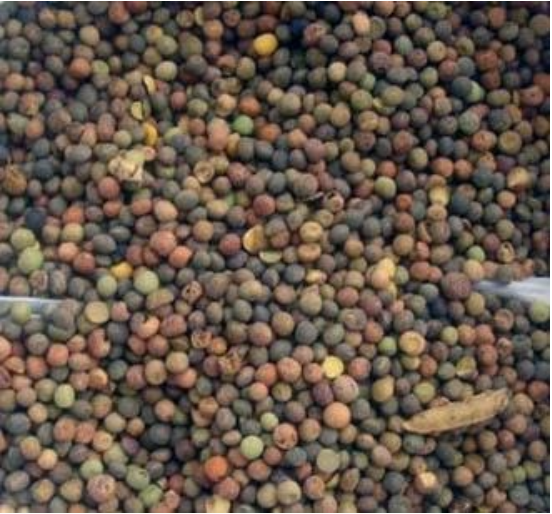Crop: Pisum sativum L. subsp. sativum var. arvense (Field pea)
In the past the cultivation of ‘Roveja’ was widely carried out in the Apennine mountains between the regions of Umbria and Marche (central Italy). Historical documents report its cultivation as fresh or dry feed while just few documents report its use as food legume. A document of 1883 named ‘Inchiesta agraria e sulle condizioni della classe agricola’ (literally: Survey about agriculture and conditions of farmers) reports that two different ‘versions’ of ‘Roveja’ were used: an early- and a late-season one. In second half of the XX century the production of ‘Roveja’ collapsed due the market request of producing high yielding and high energetic forages; rapidly its cultivation disappeared. In 1998, a farmer based in Civita di Cascia (Perugia, Italy), found 300 g of seeds, probably the very last accession of ‘Roveja’ in the area. The farmer started multiplicating the seeds and shared them with other farmers within the municipality of Cascia (Perugia, Italy).
Plants are characterised by an erect growth habit before the harvest when, plant lodging occurs. Each node carries 2-3 purple flowers. Pods measures on average 48 mm in length and 9 mm in width. Seed colour can vary from green to light green, also seed characterised by a variable seed coat pattern are present; the ilum has the same colour of the tegument.
Within the traditional cultivation area, in which temperatures are relatively low during winter, the sowing is carried out in early spring (beginning of March) and the flowering occur after 4 months. The harvest is generally carried out at the end of July.
Cultivation System: low-input conditions.
Geographical Information
Country: Italy
According to some historical documents, the traditional cultivation area of ‘Roveja’ comprised the municipalities of Norcia, Cascia and Preci (Perugia, Italy). In 1998, no one cultivated ‘Roveja’ anymore until a farmer found an old seed lot and started multiplicating it again within the farm in Civita di Cascia (Perugia, Italy). The farmer shared seeds with other producer and nowadays ‘Roveja’ is cultivated again in the traditional area. Nowadays the cultivation is carried out from 600 to 1200 m a.s.l.
Farmer(s) description:
Few farmers within the cultivation area still cultivate ‘Roveja’. They are grouped in an association and they all use material (i.e. seeds) derived from the original accession found in 1998 as no other seed lot was rescued.
Propagation system: Seed, self-pollination
Multiplication procedures and consequences on landrace diversity:At harvest farmers do not apply any conscious selection as they randomly bulk seeds for the sowing of the following year. Within the cultivation area each farmer developed a population starting from the same accession that was found in 1998 and shared by the farmer that brought back the cultivation of this landrace in the traditional area. Currently farmers do not exchange seed lots.
The multiplication procedure without the application of any conscious selection ensures ‘Roveja di Civita di Cascia’ adaptation to the cultivation area and preservation of useful within population genetic diversity.
Management plan existence:The landrace management relies completely on farming activities in the area. Currently, no technical or scientific support is given.
Added Values
As ‘Roveja di Civita di Cascia’ is included among the so-called ‘Slow Food presidia’, both local and national markets are growing even if the production is still limited.
Others (e.g. commercial/geographical brands or special traits):In 2015 ‘Roveja di Civita di Cascia’ was included into the Regional Register of Landraces (Umbria Region, Italy), implementing the Umbria Region Law concerning the protection of local genetic resources (n. 25, 2001).
The landrace also caught the interest of the Slow Food movement which included it among its ‘presidia’.
Provisions set by Regione Umbria the quality of the product, the increased perception of the landrace value and a renewed interest in agriculture give hope of on-farm conservation in the next future.
Information on the diversity within the landrace would allow to establish proper actions optimize on farm conservation strategies.
Uncertain. To have access to the resource ‘Regione Umbria’ (http://www.regione.umbria.it/agricoltura) or ‘3A-PTA’ (http://www.parco3a.org/pagine/contatti-004) should be contacted.
Case study prepared by Dipartimento di Scienze Agrarie, Alimentari e Ambientali (DSA3), Università degli Studi di Perugia (UNIPG), Italy.
Most of information have been retrieved from 3A-PTA website (http://biodiversita.umbria.parco3a.org/schede/roveja-accessione-di-civita-di-cascia).
Information were also communicated by Dr Renzo Torricelli (Università degli Studi di Perugia).
ND.
